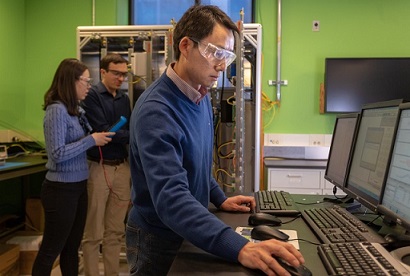GE Research, the R&D arm of U.S. conglomerate General Electric, recently secured $4.2 million in funding from the U.S. Department of Energy Solar Energy Technologies Office (SETO) to develop grid-forming solar inverter control technologies, in order to facilitate the integration of intermittent solar into power networks.
The group explained in a short press release that it plans to develop “grid-forming” controls to allow wind and solar inverters to form voltage and frequency levels like traditional generators,. It said that it expects to develop a comprehensive solution involving advanced grid-forming controls, system modeling, and extensive tests and validation.
Source control
“The fundamental grid-forming control being developed through our project with the [Department of Energy] will be based on GE’s voltage source control, or virtual synchronous generator control as it is typically called today,” Maozhong Gong, senior electrical engineer at GE Global Research, told pv magazine.
Gong said the synchronous generator has already been field-proven in GE’s current storage systems. “This includes the storage system that was part of the world’s first hybrid battery gas system that achieved the first blackstart of a power plant in California in 2017,” he said.
Work on the grid-forming control technology will occur in a series of steps. “More advanced controls will be developed on this project to enhance the transient performance of the grid forming inverter, which involves the transient control during voltage ride through, distributed transient virtual impedance control and consensus based multiple inverter control,” Gong explained.
Modeling methods
Gong and his colleagues also plan to perform both analytical and electromagnetic modeling.
“The analytical modeling will be based on a new method to develop an impedance model of a large system with different generation sources to improve a system’s small signal stability,” Gong said. “The electromagnetic modeling will be performed to study the interaction and impact of the grid forming inverters under many different scenarios.”
GE believes that the project will help to commercialize new developments. “Being able to test and validate them in different grid scenarios with a real GE PV inverter platform will be important toward realizing this objective,” Gong added. “And working with GE’s Renewables business, the National Renewable Energy Laboratory (NREL), and our academic and utility partners, we will be able to demonstrate new technologies both at inverter level and system level.”
Inverter platform
The inverter platform is the General Electric LV5 inverter, which the group claims to have deployed at around 26 GW renewable-energy power plants throughout the world.
The three-level inverter platform features 1,000/1,500 VDC voltage level, a water-cooling system that the company claims require less maintenance, and an indoor/outdoor configuration, which provides greater flexibility, the manufacturer said.
“Its advanced grid support features ensure smooth integration of power produced into the grid and manages reactive power regulation at the grid connection point, meeting all the major grid requirements,” Gong explained.
GE scientists are confident that they can create an individual inverter controller that will mainly focus on improving grid-forming performance at the inverter level by addressing issues related to stability, interaction, fault ride-through, and dynamic current limiting.
“When considering an inverter-dominated future power grid, the aggregated behavior of all grid-forming inverters is critical to maintaining system stability in both normal situations and fault conditions,” Gong explained. “We will develop new control technologies such as the coordination and synchronization among multiple grid-forming resources, distributed virtual impedance control, smart PV reserve control to improve the transient stability of the system with high renewable penetration.”






